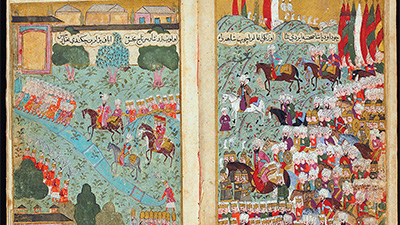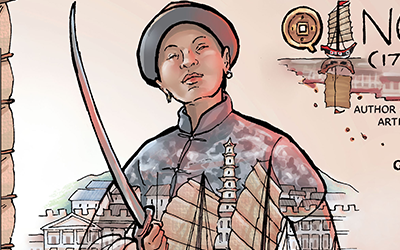Empires: Administration
Teacher Resources
Driving Question: How did rulers legitimize and consolidate their power in land-based empires from c. 1450 to 1750 CE?
The large, land-based empires of the fifteenth to eighteenth century had to tackle the momentous task of consolidating, legitimizing, and maintaining power over diverse populations. In order to do this, governments around the world developed ways to collect revenue, develop militaries, and use culture and religion to retain and expand power.
Learning Objectives:
- Examine how rulers used a variety of methods, such as the use of bureaucracies, religion, art, architecture, and tribute and tax collection, to legitimize and consolidate their power in land-based empires from 1450 to 1750.
- Learn about the historical reasoning process of analyzing change and continuity over time (CCOT).
- Use a graphic biography as a microhistory to support, extend, or challenge the narratives of this period.
Vocab Terms:
- imperial
- infrastructure
- revenue
- Sikh
- sultan
- tariff
- tsar
Opener: Empires: Administration
To teach this lesson step, refer to page 2 of Lesson 3.2 Teaching Guide.
New to teaching Continuity and Change Over Time? Check out this one-pager for information on this historical thinking skill.
Understanding how things change over time is important for understanding and properly analyzing history. This activity will help you become cognizant of such changes.
Legitimizing and Consolidating Power
To teach this lesson step, refer to page 3 of Lesson 3.2 Teaching Guide.
Check out this blog for tips to help students to engage with text.
Successful leaders may vary in their approach, but often there is a commonality among those who are able to hold on to (and maintain) power.
-
Guiding Questions
-
Before you read
Preview the questions below, and then skim the article. Be sure to look at the section headings and any images.
While you read
Look for answers to these questions:
- How did the empire of Ming China raise funds, and what was one big problem with this system?
- Besides taxing land and production, what other ways could the states in this article collect revenue?
- What did taking the title of caliph mean for rulers in the Ottoman Empire and why was this title important?
- Why did Mughal rulers—who ruled much of South Asia—have to be sensitive about making religious claims?
- What were some strategies highlighted in this article in which empires used bureaucracies and different sectors of society to help maintain their rule?
After you read
Respond to the following questions:
- To what extent does this article explain how and why various land-based empires developed and expanded from 1450 to 1750?
- Based on the information in this article, how did different rulers in different states use culture and religion to enhance their legitimacy in the eyes of their subjects?
Graphic Biography: Qing Shih
To teach this lesson step, refer to page 4 of Lesson 3.2 Teaching Guide.
This blog, “History Stories and Comics”, highlights the use of graphic histories to elevate the lives of everyday individuals often lost in traditional history.
What can a pirate queen teach you about the expansion and power of land-based empires?
-
Guiding Questions
-
Before you read
Skim the full comic, paying attention to things like prominent colors, shapes, and types of text and fonts. How do you know where to start and which direction to read? What’s in the gutters (the space between panels)? Who is the focus of the comic? What big questions do you have?
While you read
Look for answers to these questions:
- How and why did Qing Shih get to Guangzhou?
- What was Guangzhou like in 1775, according to the author?
- How did Qing Shih become a pirate queen?
- How did Qing Shih strengthen the pirate confederacy? What policies did she pursue?
- The artist shows Qing Shih at the edge or towards the back of panels at the beginning of the biography, but by the end she is in the middle and front of each panel. What message is she giving through this placement?
After you read
Respond to the following questions:
- How does this graphic biography challenge the information you’ve learned thus far about the expansion and power of land-based empires from c. 1450 to 1750?
- How does this biography of Qing Shih support, extend, or challenge what you have learned about the “gunpowder empires,” and government generally, in this era?
Closer: Empires: Administration
To teach this lesson step, refer to page 5 of Lesson 3.2 Teaching Guide.
Ever heard of pin the tail on the donkey? Now it’s time to pin the state on the strategy!





